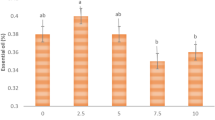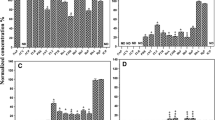Abstract
The present study provided an evidence for selective changes of the fatty acid methyl esters (FAMEs) of Canavalia seeds and the low doses of electron beam irradiation (EBI; 2.5 and 5 kGy) serve as hormetic doses for selective enhancement of fatty acids. The total lipids and FAMEs of irradiated Canavalia cathartica and Canavalia maritima seeds of the coastal sand dunes of Southwest India were assessed using soxhlet extraction and chloroform–methanol–water extraction (Bligh and Dyer) methods followed by gas chromatography. As the EBI dose increased, total lipid extraction decreased by soxhlet method in seeds of C. cathartica, while it was reverse in C. maritima. Among the doses, 5 and 10 kGy resulted in the highest extraction of lipid by the Bligh and Dyer method in C. maritima and C. cathartica, respectively. A great variation in FAMEs profile of Canavalia seeds subjected to EBI was seen by the soxhlet and Bligh and Dyer methods of extraction. The EBI increased saturated fatty acids in both the seeds. The unsaturated fatty acids were decreased by EBI based on the soxhlet extraction (except for 15 kGy in C. maritima), while a dose-dependent increase was shown by the Bligh and Dyer method on attaining the highest at the doses 5 kGy (C. maritima) and 10 kGy (C. cathartica). The changes in medium chain fatty acids, long chain saturated fatty acids, mono- and polyunsaturated fatty acids, and ratios of fatty acids were dependent on the seed material, the dose EBI, and the method of extraction.




Similar content being viewed by others
References
Adeogun, A. I., & Adeogun, M. B. (2009). Effect of irradiation and extractive solvents on the Thevetia seed. African Journal of Biotechnology, 8, 841–843.
Ali, M., & Kumar, S. (2000). Problems and prospects of pulses research in India. Indian Farm, 50, 4–13.
AOAC (Association of Official Analytical Chemists) (1999). In P. Cunniff (Ed.), Official Methods of Analysis (16th Edition). Maryland, USA: AOAC International.
Baer, D. J., Judd, J. T., Kris-Etherton, P. M., Zhao, G., & Emken, E. A. (2003). Stearic acid absorption and its metabolizable energy value are minimally lower than other fatty acids in healthy men fed mixed diets. The Journal of Nutrition, 133, 4129–4134.
Bhagya, B., & Sridhar, K. R. (2009). Ethnobiology of coastal sand dune legumes of southwest India. Indian Journal of Traditional Knowledge, 9, 611–620.
Bhat, R., & Karim, A. A. (2009). Exploring the nutritional potential of wild and underutilized legumes. Comprehensive Reviews in Food Science and Food Safety, 8, 305–331.
Bhat, R., Sridhar, K. R., Young, C.-C., Arun, A. B., & Ganesh, S. (2008). Composition and functional properties of raw and electron beam irradiated Mucuna pruriens seeds. International Journal of Food Science & Technology, 43, 1338–1351.
Bligh, E. G., & Dyer, W. J. (1959). A rapid method of total lipid extraction and purification. Canadian Journal of Biochemistry and Physiology, 37, 911–917.
Dhellot, J. R., Matouba, E., Maloumbi, M. G., Nzikou, J. M., Dzondo, M. G., Linder, M., et al. (2006). Extraction and nutritional properties of Solanum nigrum L. seed oil. African Journal of Biotechnology, 5, 987–991.
Eaton, S. B., & Konner, M. (1985). Paleolithic nutrition: a consideration of its nature and current implications. The New England Journal of Medicine, 312, 283–289.
FAO (2000). Food insecurity: when people live with hunger and fear starvation. Rome, Italy: FAO.
FAO-WHO (1998). Preparation and use of food-based dietary guidelines. Report of joint FAO-WHO consultation. Technical Report Series # 880, Geneva: FAO.
Farkas, J. (1988). Irradiation of dry food ingredients. Boca Raton, Florida: CRC Press.
Farkas, J. (1998). Irradiation as a method for decontaminating food—a review. International Journal of Food Microbiology, 44, 189–204.
Garcia-Ayuso, L. E., Velasco, J., Dobarganes, M. C., & Luque de Castro, M. D. J. (2000). Determination of the oil content of seeds by focused microwave-assisted soxhlet extraction. Chromatographia, 52, 103–108.
Gebauer, S. K., Psota, T. L., Harris, W. S., & Kris-Etherton, P. M. (2006). n-3 Fatty acid dietary recommendations and food sources to achieve essentiality and cardiovascular benefits. The American Journal of Clinical Nutrition, 83, 1526S–1535S.
Gogus, U., & Smith, C. (2010). n-3 Omega fatty acids: a review of current knowledge. International Journal of Food Science & Technology, 45, 417–436.
Gupta, B. L., Narayan, G. R., Nilekani, S. R., Bhat, R. M., Kaul, A., Bemalkhedkar, M. M., et al. (1999). Preliminary dosimetry studies for a Microtron using chemical dosimeters. Journal of Radiation Protection and Environment, 22, 169.
Howell, R. W., & Collins, F. I. (1957). Factors affecting linolenic and linoleic acid content of soybean oil. Agronomy Journal, 49, 593–597.
Koh, S. P., Arifin, N., Tan, C. P., Yusoff, M. S. A., Long, K., & Lai, O. M. (2008). Deep frying performance of enzymatically synthesized palm-based medium- and long-chain triacylglycerols (MLCT) oil blends. Food and Bioprocess Technology. doi:10.1007/s11947-008-0138-y.
Lagarde, M., Spector, A. A., Galli, C., Hamazaki, T., & Knapp, H. R. (1999). Fatty acids and lipids from cell biology to human disease. Lipids, 34, S1–S350.
Lennie, T. A., & Steward, D. K. (2001). Balance between coronary heart disease: the editorial opinions. Nutrition, 17, 741–742.
Man, Y. B. C., & Tan, C. P. (1999). Effects of natural and synthetic antioxidants on changes in refined, bleached, and deodorized palm olein deep-fat frying of potato chips. Journal of the American Oil Chemists’ Society, 76, 331–339.
Martínez, B., Miranda, M., Vázquez, S. I., Fente, C. A., Franco, C. M., Rodríguez, J. L., et al. (2009). Development of a hamburger patty with healthier lipid formulation and study of its nutritional, sensory, and stability properties. Food and Bioprocess Technology. doi:10.1007/s11947-009-0268-x.
Nareshkumar, S. (2007). Capillary gas chromatography method for fatty acid analysis of coconut oil. Journal of Plantation Crops, 35, 23–27.
Niyas, Z., Variyar, P. S., Gholap, A. S., & Sharma, A. (2003). Effect of γ-irradiation on the lipid profile of nutmeg (Myristica fragrans Houtt.). Journal of Agricultural and Food Chemistry, 51, 6502–6504.
Pala, V., Krogh, V., Muti, P., Chajès, V., Riboli, E., Micheli, A., et al. (2001). Erythrocyte membrane fatty acids and subsequent breast cancer: a prospective Italian study. Journal of the National Cancer Institute, 93, 1088–1095.
Pastor-Cavada, E., Juan, R., Pastor, J. E., Alaiz, M., & Vioque, J. (2009). Fatty acid distribution in the seed flour of wild Vicia species from Southern Spain. Journal of American Oil Chemical Society, 86, 977–983.
Pattanaik, C., Reddy, C. S., & Dhal, N. K. (2008). Phytomedicinal study of coastal sand dune species of Orissa. Indian Journal of Traditional Knowledge, 7, 263–268.
Ramadan, M. F., Showky, H. E., & Sulieman, A. E. M. (2008). Comparison between the effect of γ-irradiation and roasting on the profile and antioxidant activity of wheat germ lipids. Grasas y Aceites, 59, 166–173.
Rao, T. A., & Sherieff, A. N. (2002). Coastal ecosystem of the Karnataka State, India II—beaches. Bangalore, India: Karnataka Association for the Advancement of Science.
Schmid, P., Hunter, E., & Calvert, I. (1973). Extraction and purification of lipids. III. Serious limitations of chloroform and chloroform-methanol in lipid investigations. Physiological Chemistry and Physics, 5, 151–155.
Seena, S., & Sridhar, K. R. (2006). Nutritional and microbiological features of little known legumes, Canavalia cathartica Thouars and C. maritima Thouars of the southwest coast of India. Current Science, 90, 1638–1650.
Siddappa, K., Ganesh, S., Balakrishna, K. M., Ramamurthi, S. S., Soni, H. C., Shrivastava, P., et al. (1998). Variable energy Microtron for R & D Work. Journal of Radiation Physics and Chemistry, 51, 441–442.
Simopoulos, A. P. (1991). Omega-3 fatty acids in health and disease and in growth and development. The American Journal of Clinical Nutrition, 54, 438–463.
Simopoulos, A. P. (1997). ω-3 Fatty acids in the prevention–management of cardiovascular disease. Canadian Journal of Physiology and Pharmacology, 75, 234–239.
Simopoulos, A. P. (2002). The importance of the ratio of omega-6/omega-3 essential fatty acids. Biomedicine & Pharmacotherapy, 56, 365–379.
Simopoulos, A. P. (2004). Omega-6/omega-3 essential fatty acid ratio and chronic diseases. Food Reviews International, 20, 77–90.
Simopoulos, A. P., Kifer, R. R., Martin, R. E., & Barlow, S. M. (1991). Health effects of ω-3 polyunsaturated fatty acids in seafoods. World Review of Nutrition and Dietetics, 66, 1–592.
Siriamornpun, S., Li, D., Yang, L., Suttajit, S., & Suttajit, M. (2006). Variation of lipid and fatty acid compositions in Thai Perilla seeds grown at different locations. Songklanakarin Journal of Science and Technology, 28, 17–21.
Smolinske, S. C. (1992). Handbook of food, drug and cosmetic excipients. Boca Raton, Florida: CRC Press.
Sridhar, K. R., & Seena, S. (2006). Nutritional and antinutritional significance of four unconventional legumes of the genus Canavalia—a comparative study. Food Chemistry, 99, 267–288.
StatSoft (2008). Statistica, Version 8. Oklahoma: StatSoft Inc.
Steiner, K. G. (1996). Causes of soil degradation and approaches to sustainable soil management. Weikersheim, Germany: Margraf-Verlag.
St-Onge, M.-P., & Jones, P. J. H. (2003). Greater rise in fat oxidation with medium-chain triglyceride consumption relative to long-chain triglyceride is associated with lower initial body weight and greater loss of subcutaneous adipose tissue. International Journal of Obesity, 27, 1565–1571.
Terés, S., Barceló-Coblijn, G., Benet, M., Alvarez, R., Bressani, R., Halver, J. E., et al. (2008). Oleic acid content is responsible for the reduction in blood pressure induced by olive oil. Proceedings of the National Academy of Sciences of the United States of America, 105, 13811–13816.
Weber, P. C. (1989). Are we what we eat? Fatty acids in nutrition and in cell membranes: cell functions and disorders induced by dietary conditions. In: Fish fats and your health. Svanoy Foundation, Norway Report, 4, 9–18.
Werteker, M., Lorenz, A., Johannes, H., Berghofer, E., & Findlay, C. S. (2010). Environmental and varietal influences on the fatty acid composition of rapeseed, soybeans and sunflowers. Journal of Agronomy and Crop Science, 196, 20–27.
WHO (1999). High Dose Irradiation: Wholesomeness of Food Irradiated with Dose above 10 kGy. Technical Report Series # 890, Geneva.
Acknowledgments
Authors are grateful to Mangalore University for their permission to carry out this study at the Department of Biosciences. This research was funded by the BRNS, Bhabha Atomic Research Centre, Mumbai, India (2004/34/32/BRNS/30156.3.09).
Author information
Authors and Affiliations
Corresponding author
Rights and permissions
About this article
Cite this article
Supriya, P., Sridhar, K.R., Nareshkumar, S. et al. Impact of Electron Beam Irradiation on Fatty Acid Profile of Canavalia Seeds. Food Bioprocess Technol 5, 1049–1060 (2012). https://doi.org/10.1007/s11947-010-0420-7
Received:
Accepted:
Published:
Issue Date:
DOI: https://doi.org/10.1007/s11947-010-0420-7




